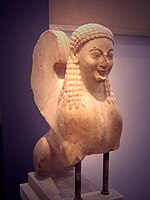Archaic smile

The archaic smile was used by sculptors in Archaic Greece,[1][2] especially in the second quarter of the 6th century BCE, possibly to suggest that their subject was alive and infused with a sense of well-being. One of the most famous examples of the archaic smile is the Kroisos Kouros, and the Peplos Kore is another.
By the middle of the
The Greek archaic smile is also found on Etruscan artworks during the same time period nearby on the west side of the Italian peninsula, as consequence of the influence of Greek art on Etruscan art. An example of this commonly featured in art history texts is the Sarcophagus of the Spouses, a terracotta work found in the necropolis of Cerveteri. It features a smiling couple reclined seemingly at a banquet. The slight geometric stylization, level of realism and physical scale are also strikingly similar to Greek works from this period featuring the archaic smile.
Gallery
-
Glyptothek Munich
-
Head of aNational Archaeological Museum of Athens
-
TheMoscophoros of the Acropolis, ca 570 BCE
-
Votive sphinx from the Acropolis
-
Warrior from the west pediment of theGlyptothek Munich
See also
References
- ^ a b c
A Brief History of the Smile, Angus Trumble,
2005, ISBN 0-465-08779-5, p.11, Google Books link.
- ^ a b
"Archaic smile", Britannica Online Encyclopedia, 2009, webpage: Archaic-smile EB-Smile.
- ^ Middle Archaic Phase(Smile) Retrieved 24 September 2010
- ISBN 9780500288771.





